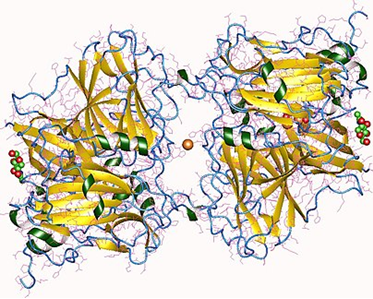MultLaccases(sensu stricto) subfamily-Copper Oxidase
Laccase is a polyphenol oxidase containing four copper ions. It belongs to the copper blue oxidase and exists as a monomer glycoprotein. Laccase exists in mushrooms, bacteria and plants, and can also survive in the air. The only product after the reaction is water, so it is essentially an environmentally friendly enzyme. The unique catalytic properties of laccase make it widely used in biological detection, and as an efficient biodetector, it becomes an effective tool and means for the analysis of components such as substrates, coenzymes and inhibitors. As environmental protection awareness has been gradually valued in recent years, laccase has become the research object of many scholars in recent years.
 Figure 1. Structure of Laccase.
Figure 1. Structure of Laccase.
Origin
Laccase was first found in the secretion of lacquer tree and exists in the cell walls of many higher plants, such as the buds of tea leaves. Higher plant-derived laccases are reported less frequently than fungal laccases. The laccase used in production mainly comes from bacteria and fungi, and most fungi secret laccase. The main producing strains at home and abroad are white-rot fungi. Domestic research on the application of laccase mainly focuses on the decomposition of lignin, pulp bleaching, decolorization of dye wastewater, and degradation of toxic substances in the environment.
Physical and chemical properties
Laccase is a copper protein, blue, with a molecular weight of about 120,000 and containing 4 atomic copper, which can be inhibited by CN-. Laccase can oxidize polyphenols, promote the methoxy substitution of phenol and diamine, and oxidize almost all substrates with similar structure of p-polyphenol. In addition, some fungal laccases can also oxidize monophenols such as cresol and ascorbic acid.
Active site
The active site consists of four copper centers, which adopt a structure divided into type I, type II and type III. The Tricopper ensemble contains Type II and Type III copper (see picture). It is this center that combines O2 and reduces it to water. Each Cu (I, II) pair passes one electron required for this conversion. Type 1 copper does not bind to O2, but serves only as an electron transfer site. Type I copper centers consist of a single copper atom linked to at least two histidine residues and one cysteine residue, but in some laccases produced by certain plants and bacteria, type I copper centers contain an additional methionine ligand. Type III copper centers consist of two copper atoms, each of which has three histidine ligands and are interconnected by a hydroxide-bridged ligand. The final copper center is a type II copper center, which has two histidine ligands and one hydroxide ligand. Type II and type III copper centers together form a three-copper complex where dioxygen reduction occurs. Type III copper can be replaced by Hg (II), which results in reduced laccase activity. Cyanide removes all copper from the enzyme, and it has proven impossible to fully embed type I and type II copper. However, type III copper can be re-embedded in the enzyme. A variety of other anions can inhibit laccase. Laccase affects the oxygen reduction reaction at low overpotential. The enzyme has been studied as a cathode in enzyme biofuel cells. They can be paired with an electron mediator to facilitate electron transfer to the solid electrode wire. Laccases are some of the few redox enzymes commercialized as industrial catalysts.
Applications
Edible fungus production
In the production process of edible fungus seed production, the addition of laccase preparation can accelerate the decomposition of aromatic polymer compounds such as lignin, provide nourishment for mycelium, and participate in the electron transfer of the respiratory process as oxidase, providing more energy and promoting mycelium. The body synthesizes, operates and accumulates substances, thereby accelerating the growth of mycelium and shortening the time of seed production. In the process of bag cultivation, mycelium can be kinked to form more fruiting body primordia and increase the yield of mushrooms. Throughout the production process, laccase preparations can oxidize phenol into quinones as a toxin that resists germs and inhibits germ contamination.
Indicator for Botrytis cinerea infection
Laccase produced by Botrytis cinerea can cause various forms of grapes to rot. When laccase activity can be detected in grape juice or wine, it indicates that the raw grape used for production is infected by Botrytis cinereal. However, it is not reliable to determine the exact proportion of contamination by measuring the amount of enzyme activity in the corresponding grape juice, because the increase in enzyme activity and the number of contaminated grapes are disproportionate.
Reference
- Solomon EI.; et al. Multicopper Oxidases and Oxygenases. Chemical Reviews. 1996, 96 (7): 2563-2606.